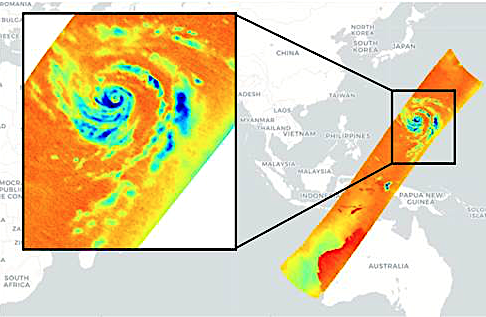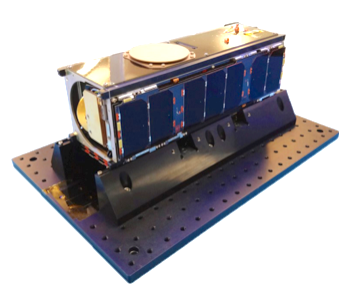

Typhoon Hagibis imagery at 118 GHz, revealing important data about internal storm structure.
Japan's Typhoon Hagibis continues to create destruction and havoc dramatically seen from Orbital Micro Systems' (OMS) IOD-1 GEMS satellite.
Typhoon Hagibis has strengthened dramatically in recent days, representing the greatest intensification of a Western Pacific storm since Typhoon Yates in 1996. OMS captured observations of the storm October 8, 2019 at 12:36 a.m. UTC, shortly after the typhoon intensified from a 60-mph tropical storm to a 150-mph super typhoon in 18 hours.
The data shows the beginning of the eyewall replacement cycle, a process that occurs with particularly strong storms. During this scan, a core of warmer air — depicted as darker red colors on the right side of the storm — is being drawn into the center of the storm. This warmer air represents a temporary weakening of the storm as a prelude to the development of a new eyewall and further strengthening.

IOD-1 GEMS 3U demonstration satellite deployed 3 July 2019
Michael Hurowitz, chief technology officer for OMS stated that the GEMS 118 GHz, 8 channel microwave radiometer has delivered exceptional spatial resolution and sensitivity in providing imagery and sounding data from Typhoon Hagibis competitive with multi-billion-dollar government programs performing similar measurements. These images validate the capability of OMS’ remote sensing technology and have demonstrated the highest spatial resolution of any passive microwave temperature sounder flown in space on an operational mission.
The raw data downlinked from the satellite was processed at OMS’s International Centre for Earth Data (ICED) located in Edinburgh, Scotland.
Hurowitz added that observed data from this satellite can be combined with information from government-owned systems to improve the accuracy of storm forecasts. They are working with other providers and partners to provide enhanced weather information that improves safety margins for people and businesses facing severe weather events.
For more information about Orbital Micro Systems and the International Center for Earth Data, please visit https://www.orbitalmicro.com/gems.

